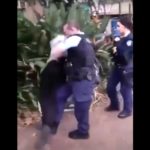Victim of Police Brutality Commences Legal Proceedings

An Indigenous man is seeking damages in the New South Wales Supreme Court for spinal injuries sustained as a result of being violently thrown to the ground by police officers.
The Court has heard the man sustained significant injuries including incomplete quadriplegia, cervical myelopathy, lower limb spasticity, a cervical spine injury and seven fractured ribs after the incident in Sydney’s south-west in March 2016.
The story so far
Mr Armstrong was the passenger in a utility which was pulled over for a breath test at Horningsea Park. It was the second time the duo had been stopped in a “very short period”.
The breath test returned a negative result, yet two officers from Strike Force Raptor directed him and the driver to step out of the car and place their hands on their heads, so a search could be conducted.
Violently thrown to the ground
Mr Armstrong says that despite complying with the request, he was “violently thrown to the ground”.
He says the officers searched him for for an extended period of time while he lay injured, and did not call an ambulance, before telling him he was free to go.
He is seeking damages, including aggravated and exemplary damages, in his action for trespass to person, negligent battery and negligence.
Court document outline that police were never formally reprimanded for their actions, and have ‘dishonestly maintained’ that the phone in Mr Armstrong’s hand “was a suspicious metallic item in order to justify the assault”.
The defence
In its defence, the State of New South Wales contends the car Mr Armstrong was travelling in was associated with the Rebels outlaw motorcycle gang, and that police suspected on reasonable groundst it may have contained prohibited firearms and weapons due to an “ongoing violent dispute” between two bikie gangs, the Rebels and the Finks.
The defence also claim that one of the officers genuinely believed the “metallic object” in Mr Armstrong’s hand may have been a weapon, and feared “a violent confrontation and used such force as reasonably necessary … namely a ‘leg sweep’.”
The State denies that Mr Armstrong is entitled to any damages or costs, and says any injury or disability he suffered has “no causal connection” to the actions of the Strike Force Raptor officers that day. It says the injuries were “caused by the plaintiff’s own provocative actions in tensing his arms and hindering the personal search attempted by [the officer] upon him.”
It has also asserts that the plaintiff’s injury occurred in the course of a lawful investigation and/or suppression of crime, and therefore attracts immunity.
As usual, taxpayers will foot the bill in the event the plaintiff is successful.
It is not clear whether the incident, which involves allegations of serious police misconduct has been referred to the Law Enforcement Conduct Commission (LECC) which lists investigations on its website.
Strike Force Raptor
Earlier this year, the LECC investigated an incident involving officers from Strike Force Raptor who intimidated a lawyer who was representing a client in a case involving the elite squad, to the point he fled the courtroom through the magistrate’s private exit and told his client to find new legal representation.
There have long been community concerns about the way this particular police squad operates.
The case has been expedited to the Supreme Court of NSW because of the care and assistance that Mr Arstrong now requires.
The tort of battery (harming a person)
Torts are civil claims brought by an individual who seeks compensation from the tortfeasor (the person / group of people / organisation which committed the tort) for injury or loss. In civil torts the onus of proof is on the injured person, or the person seeking damages to prove a number of matters before damages can be awarded.
Battery
Battery occurs when the defendant directly and deliberately causes offensive physical contact to the plaintiff; without the plaintiff’s consent or other legal justification.
A battery commonly arises in the following circumstances:
- in the context of an arrest made by police, where police have used excessive force;
- where police or Corrective Services officers have used excessive force whilst conducting forensic and other procedures; or
- where security guards or ‘bouncers’ have used excessive force in removing patrons from bars and clubs.
The plaintiff must demonstrate the following elements, to establish that a battery has occurred:
- There was an intentional or negligent act of interference (physical contact with the plaintiff’s body).The defendant’s act caused physical interference, or contact with the plaintiff’s body. This can also include contact with the plaintiff’s clothes, spitting in someone’s face, causing a person to be touched with another object or throwing a person out of a chair by touching only the chair, and not the person.
- The interference was direct or immediate upon the defendant’s act. The interference to the plaintiff must be direct and immediate upon the defendant’s act, and not consequential. This issue may not arise in cases involving physical contact, however can be more difficult to identify in cases involving mental harm.For example, in a recent Victorian case, it was held that witnessing injuries resulting from a domestic violence incident where police were involved could not be sufficiently linked to the conduct of police, and the actions of police were not sufficiently direct enough to cause the plaintiff’s harm, and
- Such contact was offensive, likely to cause injury or affront. There is a requirement that the defendant’s act must be ‘angry, revengeful, rude, insolent or hostile.’ Physical contact resulting from the exigencies of daily life will not amount to battery. For example, a casino employee touching a patron on the shoulder in order to get his attention is not enough to amount to a battery. The presence of hostility in an act is what distinguishes a battery from contact in the ordinary course of daily life.
Once physical contact has been established, the defendant must prove that the act was not ‘intentional’.
In the context of police conduct, it is often argued that the defendant was using force necessary to perform an arrest. Under the Law Enforcement (Powers and Responsibilities) Act 2002 (NSW) (the LEPRA), police officers are able to use “such force as is reasonably necessary to make the arrest or to prevent the escape of the person after arrest” so the plaintiff must demonstrate that the conduct went beyond what was necessary in the circumstances.
Negligence
Negligence in NSW is defined in the Act as arising when a person does not exercise what would be considered reasonable care and skill.
A claim of negligence in NSW would arise when a person (the negligent party) breaches their common law duty of care owed to another (the claimant) which results in some damage or injury.
To make a claim of negligence in NSW, you must prove three elements:
- A duty of care existed between you and the person you are claiming was negligent;
- The other person breached their duty of care owed to you; and
- Damage or injury suffered by you was caused by the breach of the duty.
Duty of care
Duty of care in cases of negligence in NSW can be established through the type of relationship between the claimant and the negligent party. There are many kinds of duties of care and they can arise in many different instances.
If there is an element of danger, the person who owes the duty must perform or act to a reasonable standard. Similarly, a person must take reasonable steps to avoid harm in circumstances where a duty is owed.
A failure in either case means they have breached the duty of care.
Breach of a duty of care
In case of negligence in NSW, a breach of a duty of care occurs if the claimant can show:
There was a substantial or ‘not insignificant’ risk of harm; and
- The negligent party knew, or ought to have reasonably known the risk of harm; and
- A reasonable person would have taken precautions against the risk when faced with the same circumstances.
- The court will determine whether there has been a breach of a duty of care on a case-by-case basis.
In deciding if a reasonable person would have taken precautions, the court considers the following:
- The likely severity of any harm or damage;
- The level of difficulty taking measures to avoid the harm would have been;
- The probability of the harm if the person did not take care; and
- The social benefits of the activity that created the risk of harm.
- The harm that results from the breach
- There must have been harm caused to the claimant for the breach of a duty of care owed. This is an essential element to claims for negligence in NSW.
Harm under the Act includes all forms of injury or loss, including:
- Personal injury or death;
- Damage to property; and
- Economic loss, both past and future.







